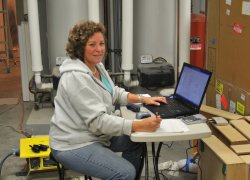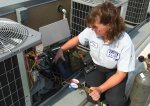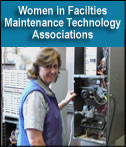Women's Success Stories
 |
CHRIS JONES "This is definitely an area where women can excel. It takes brain power, it takes organization, and it takes patience." |
Career Quick Look
| Salary: | $70K-$90K per year | Education: |
| Years in Field: | 25 years | A.S. degree, Heating, Ventilation, Air Conditioning and Refrigeration (HVACR) from San Jose City College (SJCC) |
| City/State: | Aromas, California |
Getting Started: When she was a little girl, Chris Jones' older brothers often asked her to assist with their car projects. This may have sparked her interest in mechanical devices. In high school she was the only female to sign up for auto shop. She found she enjoyed working in a hands-on environment which involved troubleshooting and solving mechanical problems. When she graduated from high school in 1977, she entered San Jose City College and enrolled in the solar technology department. Her courses included heating, air conditioning, and electrical, and since solar technology did not provide many employment opportunities at that time, she began to move toward HVACR.
She went to work part-time for a company that sold air conditioning supplies while she was in school, and later became their sole outside sales representative. During this period her interests were ultimately drawn back to technical challenges. She went back into the field as a mechanic. From 1982 to 1984, she worked for a controls company, G.J. Yamas, in South San Francisco. She graduated from San Jose City College in 1983 with an A.S. degree in Air Conditioning and Refrigeration. She also got her journeyman card in 1984 after a 4 year apprenticeship program, and was the first woman to achieve this status in the air conditioning service division.
On July 1, 1984, Chris was given a baby shower by the service department at G.J. Yamas, and was driven home by her then boss/mentor to begin her life as a homemaker and mother of 2 daughters. Although she didn't work in the field for a while, she stayed informed about the industry through her husband's mechanical contracting company. She also learned to use a computer during this time. Once her children became more independent, Chris studied for and obtained certification as an energy analyst, helping companies and home owners to meet the requirements spelled out by Title 24, the energy building code for the state of California. She started a small business doing energy analysis while her children were in school, and later worked for another company part time. In 1998, she returned to the controls industry, where she was employed until she started her own digital controls/energy management business, Digital Control Solutions, in Gilroy in 2003. She now functions as the CEO and Senior Programmer and continues to build her company.
Education: Chris Jones began attending San Jose City College right after high school. Although her initial focus was solar technology, she soon moved into HVACR, working part-time while she took courses. "Our lab at SJCC prepared us to troubleshoot problems hands-on, to actually have our hands touching meters and pieces of equipment we'd see in the field, so it wasn't a big shock. When I got out there I felt comfortable with what I was looking at," says Chris.
Her primary instructor at the time, Jerry Hurwitz, helped students find summer jobs to get hands-on experience and find out if they really liked and wanted to pursue this field. "Jerry went well above what any instructor would do to help people make sure they were on the right track. The program prepared you for real life." Because of the flexible hours, Chris was able to work while she took classes. She met her husband through her summer job as a helper at a mechanical contracting company.
Chris has also continually taught herself how to work with specific software programs that control energy use and environments. She still relies heavily on her HVACR education at San Jose City College to understand and troubleshoot the mechanical equipment which this software controls and monitors.
Greatest Professional Achievement: In addition to having started her own business, Chris is very proud of a project her company completed in December 2007. In collaboration with another company, they provided the digital controls for the first Leadership in Environmental and Energy Design (LEED) certified Platinum school building in the nation, Chartwell School in Seaside. "I was real proud of this project; we got to work collaboratively with a company in Illinois. It was huge." The trade journal Indoor Comfort News ran a story about the project in January. Twenty-five years earlier, Chris had her picture on the cover of the same publication when she was working as an apprentice.
Barriers: Chris recalls a specific incident from her early days in the field when her male colleagues didn't take her seriously because of her age and gender. "It was out at the Lockheed Space Telescope Building. I had three men in suits and contractors all looking at me because I was telling them the fans were going backwards. Here's this little 20-year old telling them the fans were going backwards. It was quite a fight to get them to listen to me. Ultimately they did." "It's a wonderful trade, but it's still a male-dominated trade, and if you come in with an attitude you'll get attitude back. If you're not a team player, you're not going to make it," she cautions.
Working with Men: Chris has always been comfortable working in a male-dominated field. Perhaps it began with older brothers who often asked her to "hold this flashlight, or pump the brake" as they worked on projects. Currently, she has just one female employee at her two-person company. She continues to work with many male contractors and installers. To this day Chris still keeps in touch with several of the men she worked with 25 years ago.
Advice for Women: Chris suggests for female students to enter this field if they find it interesting. "Do it for yourself. Don't do it to please somebody else. Do it because you want to be there and because you enjoy it," she says. Chris also encourages women entering the field to seek out answers to their questions. "Be yourself. Everyone is there to learn. If you don't know the answer, chances are someone else probably doesn't know it either, and they're just too scared to ask. So don't hold back. Make sure you demand the education you need."
"This is definitely an area where women can excel. It takes brain power, it takes organization, and it takes patience. A lot of my male counterparts can't sit still long enough to look at anything. They've got to be off doing something. They get frustrated by sitting in front of a computer and observing that the program is performing as expected. It can be tedious."
Typical Workday/Environment: In her role as CEO and Senior Programmer at her two-person company, Chris designs and delivers digital controls to manage mechanical systems such as heating and air conditioning in homes and commercial buildings. Her company provides these services for smaller contractors and electricians who don't have control divisions in-house because they're too small to make it cost effective. Chris's company does the design work and wiring diagrams, programming, and layout and builds the panels. Then, they hand it off to the contractor to install. Once installed, they make sure it works - since much of what they do is Internet-based, Chris and her employee are often able to do this from their office without visiting the site by gaining access to the controls via a password to a computer at the site.
Her company is located in a converted shop. An average day might include meeting with potential clients, receiving blueprints, doing a "Take Off" and putting a bid together, or submitting drawings. She may also work on developing wiring schematics, programming, and testing for existing clients. She orders parts, builds electrical panels, and may visit sites or work remotely to roll out systems. She responds to client's' and installers' questions and troubleshoots problems on existing systems. She also pays bills, orders parts, and takes care of other administrative and management functions.
The dress code is casual: Chris and her colleague wear yoga pants and sweat shirts when they're not meeting with clients. When they deliver a training program to a client, they wear jeans and polo shirts with their company name and logo.
Career Ladder: An entry-level controls technician doing programming could earn $35K to $40K a year, and with advancement might earn up to $60 to $70K. Senior programmers with years of experience can earn between $70 and $90K plus a year. Supervising other employees can add to salary levels, as can union membership. There are many facets of the controls field other than programming: some people enter the controls field as installers, or work for a company like Intel or a school district where they monitor the energy management systems. Some people who work in controls have mainly computer experience and don't understand how HVAC systems work. Chris believes that it is better to understand the mechanical systems that you are controlling before becoming a controls technician or software programmer.
Professional Associations: None at present.
Hobbies: When time permits, Chris enjoys going to the mountains, where they have a small getaway, camping, fishing and hiking.
 Copyright 2010 National Institute for Women in Trades, Technology & Science | http://www.iwitts.com |


